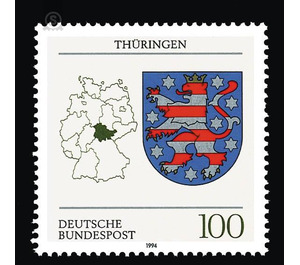Coat of arms of the Land of the Federal Republic of Germany (3) - Germany / Federal Republic of Germany 1994 - 100 Pfennig
Theme: Art & Culture
| Country | Germany / Federal Republic of Germany |
| Issue Date | 1994 |
| Face Value | 100.00 |
| Color | white blue |
| Perforation | K 13 3/4 |
| Printing Type | Multicolor offset printing |
| Stamp Type | Postage stamp |
| Item Type | Stamp |
| Chronological Issue Number | 1589 |
| Chronological Chapter | GER-BRD |
| SID | 403029 |
| In 42 Wishlists | |
With "Coat of Arms of the Federal Republic of Germany", the Deutsche Bundespost continues the series of contemporary historical topics. The stamp series is intended to draw the public's attention to the young and recent history as well as the federal structure of the Federal Republic and to be a contribution to the unity of Germany. The series is completed with the coat of arms of Thuringia. After the resurrection of the state of Thuringia on October 3, 1990, it was necessary to designate a coat of arms for the new federal state. With the law on the national emblems of the country Thuringia from 30 January 1991 the Thuringian federal state parliament decided for a coat of arms, which corresponds to the historical past of Thuringia. This law states: »The coat of arms of the country Thuringia forms an upright, eight-fold red-silver-striped, gold-crowned and gold-armored lion on a blue background, surrounded by eight silver stars.« The striped lions led the Thuringian landgraves already during the reign of Landgrave Hermann I. (1190-1217) in her coat of arms. A first surviving blazon comes from his son Konrad and is kept in Marburg. This shield shows the red and white striped lion on a blue background. The Landgraviate of Thuringia belonged to 1247 in addition to large parts of Thuringia and parts of the present state of Hesse. The Succession War from 1247 to 1263 led to the division of the county. The separated area west of the Wartburg was the new Landgraviate Hesse with Marburg as the center. The eastern part, located between Harz and Thuringian Forest, formed the landgraviate of Thuringia, now part of the Wettin family. Both the Wettin and the Hessians now took over the "colorful lions" in their coats of arms. In Thuringia the representation of this lion until 1918 was an indispensable part of the coat of arms led by the Wettinern. In 1918 common large coat of arms of Prussia is the »colorful lion« for Thuringia next to the one for Hesse. In 1815 Prussia acquired large parts of Thuringia and in 1866 also acquired further territories of Hesse. The Free States of Saxony-Weimar-Eisenach, Saxony-Altenburg, Saxony-Gotha, Saxe-Meiningen, Schwarzburg-Rudolstadt, Schwarzburg-Sondershausen and the People's State of Reuss emerged from the Thuringian Principalities in 1918-19. By the merger of these seven individual states 1920 the country Thuringia was formed. The Law on the Coat of Arms of 1921 stated: "The coat of arms of Thuringia form 7 silver stars on a red background." Thus, in this coat of arms, it was valid from 1921 to 1933, waived the representation of the lion. The seven stars symbolize the seven founding states of the state of Thuringia. The "Great Coat of Arms", introduced in 1933, contains four fields and a heart shield. In the heart shield is the landgrave lion, holding a swastika in his paw. The surrounding four fields symbolize former Thuringian parts of the country. In the national coat of arms determined in 1945 there is a lion on a red background, surrounded by eight silver stars. The star symbolism with its meaning was borrowed from the coat of arms of 1921. The eighth star stands for the 1945 added, until then Prussian parts of the Thuringian area. This coat of arms was valid until the dissolution of the country Thuringia in the year 1952. The coat of arms of the year 1991 now contains again the "colorful lion", which refers to the time of the Thuringian Landgrave. The eight stars surrounding the lion, on the other hand, embody the newer history of Thuringia. (Text: Thuringian State Chancellery, Erfurt)


